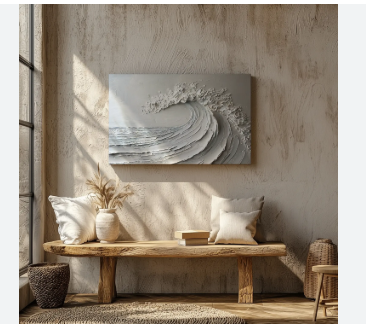Why Textured Canvas Art is the Game-Changer Your Walls Need

Your walls are talking—but are they saying something interesting? While flat prints and photographs have their place, textured canvas art brings an entirely different conversation to your space. This three-dimensional approach to wall décor doesn't just hang there looking pretty; it actively engages with light, shadow, and your sense of touch to create an ever-changing visual experience.
Textured canvas art represents a shift from passive decoration to active design element. Unlike traditional flat artwork, these pieces use raised surfaces, layered materials, and varied depths to create dimension that responds to your room's lighting throughout the day. Morning sunlight might highlight certain ridges and valleys, while evening lamplight casts entirely different shadows across the same piece.
What Makes Textured Canvas Art Different
Traditional canvas paintings rely on color, composition, and brushwork to create their impact. Textured canvas art adds a crucial third dimension. Artists build up surfaces using heavy-bodied paints, modeling paste, sand, fabric, or other materials to create peaks, valleys, and raised areas you can actually feel.
This dimensional quality means the artwork changes throughout the day. A piece that appears calm and subtle in morning light might become dramatic and bold under afternoon sun or evening lamps. The interplay between light and shadow creates a living artwork that never looks exactly the same twice.
The materials used can vary dramatically. Some artists work with thick impasto techniques, building up paint so heavily that brushstrokes become sculptural elements. Others incorporate sand, crushed glass, or fabric into their medium, creating surfaces that catch and reflect light in unexpected ways.
Popular Techniques in Textured Canvas Art
Heavy Impasto and Paint Build-Up
Artists using this technique apply paint so thickly that the brushstrokes themselves become the texture. Van Gogh famously used this method, but contemporary artists have pushed it even further. These pieces often look as much like sculptures as paintings, with paint applied in thick ridges and swirls that catch light dramatically.
Mixed Media Integration
Modern textured canvas often incorporates non-traditional materials. Artists might embed sand for a gritty coastal feel, add fabric pieces for softness, or include metallic elements for reflective highlights. These mixed media pieces blur the line between painting and sculpture.
Abstract Coastal Themes
Textured techniques work particularly well for abstract beach art. Artists can use modeling paste to suggest foam and waves, sand mixed with paint to evoke shorelines, or layered blues and whites that physically rise and fall like ocean swells. The texture enhances the oceanic feeling in ways flat paint cannot achieve.
Geometric and Minimalist Textures
Not all textured canvas art is organic and flowing. Some artists create precise geometric patterns using raised elements, or work in monochromatic palettes where texture provides all the visual interest. These pieces work beautifully in modern, minimalist spaces.
Styling Textured Canvas in Your Space
The three-dimensional nature of textured canvas art requires thoughtful placement to maximize its impact. Lighting becomes crucial—these pieces need adequate illumination to show off their dimensional qualities, but harsh direct light can create unflattering shadows.
Consider positioning textured artwork where it will receive varied lighting throughout the day. A wall that gets morning sunlight and evening lamp illumination will showcase the piece's changing character. Avoid placing highly textured works in areas with only harsh overhead lighting, which can flatten their dimensional appeal.
Scale matters more with textured pieces than flat art. The physical depth means these works have more presence, so a textured piece will appear larger than a flat painting of the same dimensions. This can be an advantage when you want maximum impact, but consider the proportions carefully in smaller spaces.
Caring for Your Textured Canvas
The raised surfaces that make textured canvas art so appealing also make it more susceptible to damage and dust accumulation. Cleaning requires gentle techniques—a soft brush or compressed air rather than cloth wiping, which might catch on raised elements.
Placement becomes important for longevity. High-traffic areas where the artwork might get bumped or touched frequently aren't ideal for heavily textured pieces. The dimensional elements that create visual interest can be fragile, especially if made from built-up paint or delicate mixed media materials.
Transform Your Space with Dimension
Textured canvas art offers something flat artwork simply cannot: a tactile, ever-changing presence that responds to your room's lighting and viewing angle. Whether you choose abstract coastal pieces that suggest ocean waves through their physical ridges and valleys, or opt for minimalist geometric textures that play with light and shadow, you're adding a dynamic element that keeps your space feeling fresh and engaging.
Ready to move beyond flat walls? Explore textured canvas options that speak to your style and watch how they transform not just your décor, but your entire relationship with your living space.







